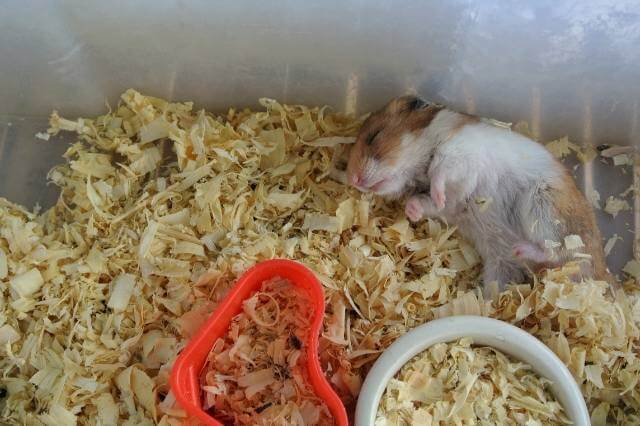It’s a good idea to conduct some study on whether and how long hamsters truly hibernate before purchasing one.
Hamsters do they hibernate?
As a form of survival, pet hamsters will begin to hibernate when the temperature drops too low or when their food supply is limited.
Please don’t assume your hamster is dead if they go into hibernation.
Table of Contents
Is the Hamster Dead or Hibernating?
Start by gauging the animal’s respiration and pulse.
During hibernation, it could be sluggish and faint, but it can still be felt.
Additionally, your hamster probably hibernated to conserve energy if the weather was cold.
Even your hamster’s body exhibits very minor shakes and motions.
For hamsters, hibernation is a typical occurrence. We’ll go into more depth about hamster hibernation here.
What Should I Do if My Hamster Goes Into Hibernation?
If your small furry friend has hibernated, they could periodically wake up to eat.
Because of this, it is wise to leave nearby fresh food, water, and nesting materials.
Hamsters who hibernate may experience severe complications such as hypothermia.
To assist their body use less energy to keep them warm, you should keep them in a setting that is maintained at a constant, warm temperature.
A lot of warm nesting materials should also be available.
If you’re unsure or if your hamster looks very chilly, speak with your veterinarian for further information.
As long as they are not in any danger or in an environment that is excessively chilly, the RSPCA of the UK advises letting your hamster hibernate.

What Causes Hamsters to Hibernate?
Hamsters have different hibernation patterns. It could have anything to do with their surroundings, heredity, or breed.
Hibernators come in two flavors: permissive and required.
No matter the weather, mandatory hibernators always hibernate throughout the winter as dictated by their internal clocks.
The first group includes hamsters like the Syrian hamster.
Syrians hibernate sometimes, depending on factors like the weather and availability of food.
Syrian hamsters may potentially hibernate at any time of year under the correct circumstances.
Cold weather is the primary cause of Syrian hamsters hibernating, according to the British Hamster Association (BHA). Another key aspect is light.
A hamster maintained in the dark and cold for more than 12 hours out of every 24 is more likely to hibernate, according to the BHA website.
This suggests that you should keep your hamster warm and in a bright room for at least 12 hours every day to prevent hibernation.
Regularly handling them is also a good idea.

How to Tell if Your Hamster Is Alive and Just Hibernating
It might be unsettling to observe your hamster immobile and lying quite still, and you’d be excused for believing your furry companion has passed dead.
Although a dead hamster and one that is hibernating might appear quite similar, there are several telltale indicators that can help you tell them apart.
Breathing
Your hamster’s respiration and pulse rate will be significantly slower while it is hibernating.
Your hamster will most likely appear to have completely ceased breathing upon close inspection.
You should be able to see some indications that your hamster is still breathing, though, if you look carefully.
If you look closely, you might be able to discern a little rise in his chest.
You should also check your hamster’s nose and whiskers since they can wiggle.
You might also approach your hamster closely to hear if you can hear it breathing.
Movement
Hamsters in hibernation may appear to be motionless, yet they nevertheless make extremely few movements.
Watch alert for jerks or twitches that may occur sometimes. To observe these motions, you might need to keep a careful eye on things.
To test whether your hamster’s paws and whiskers move, you might also softly massage them.
Limp Body
Since they are lethargic and immobile, picking up a hamster that is hibernating might seem like taking up a dead one.
When you pick up a genuinely dead hamster, he will feel hard and rigid. This is due to rigor mortis had already developed.
The muscles and joints of dead corpses experience rigor mortis, which causes them to stiffen and set in place within a few hours of the death.
A hamster in hibernation will appear languid but not rigid. His joints and limbs should be movable, something you won’t be able to achieve with a dead hamster.
Body Temperature
Your hamster will still stay somewhat warm during hibernation even if its body temperature may decrease.
Check to check whether there is any warmth when you touch your hamster. The entire body of a deceased hamster will be frigid.
Your hamster will have certain spots that are quite chilly to the touch, but other sections should still feel somewhat warm.
His cheek pouches should be one of the warmest regions, so try softly massaging there.

There Are Five Signs That Your Hamster Has Sadly Passed Away
The Fetal Position
If your hamster is in the fetal posture and not moving, that is one of the first signs that they are dead.
When a hamster dies, they often assume a stance that resembles the fetal position while lying in one of the corners of its cage or even within its little house.
You may observe them when they are in this position both from a distance and up close to their cage.
This suggests that the hamster, who is often lying on one of its sides, will have its head close to its front paws.
They will also have their short tails tucked in and their back paws will be close to their front paws.
Since they will be curled up much more than usual while they are in the fetal position, this generally differs from how they seem when they are simply sleeping.
Additionally, as hamsters are often highly active during the day, if they are in this posture during a period when they are most active, you will know that something is wrong with them.
Therefore, if you see your hamster in the fetal position, particularly at periods when they’re often active, they may have tragically passed away.
Your Hamster’s Body Won’t Move as a Result of Breathing
One of the things you won’t notice if your hamster has actually passed away is how its body moves as they breathe.
If you were to observe hamsters while they were sitting quietly, you would see that they typically breathe quickly while they are living.
However, if you examine a dead hamster’s corpse, you won’t see that kind of motion any longer.
For a few minutes or more, you must keep an eye on their chest area to check whether it moves slightly up and down if you believe they are dead.
They sometimes actually slow down how frequently they breathe, so you’ll need to watch for this movement for a few minutes or more.
However, this mostly occurs when they hibernate. They may slow down their breathing rate by taking one breath every several minutes.
You’ll need to check to see whether their body is moving while they breathe for a few minutes or longer because it might be difficult to know if they’re genuinely dead or just hibernating as a result.
If you don’t see any movement at all, your hamster is likely already dead.
Rigor Mortis
If rigor mortis has already begun, that is another sign that your hamster is dead.
If you try to pet a dead hamster or touch it in any manner, it will feel rigid to the touch.
Their bodies will feel stiff and generally harder than normal. Their muscles will also feel tight.
You won’t be able to readily move your hamster’s limbs or the rest of its body if you try to lift one of its paws up.
As a result, rather than feeling soft, all of their muscles and joints will seem virtually stiffened or locked.
If you believe that rigor mortis has taken hold and your hamster is dead, you can check this yourself.
To do this, try lightly pressing a specific area of your hamster’s body.
Rigor mortis has most certainly set in and your hamster has likely passed away if its entire body moves but remains rigid rather than just the area you pressed.

The Heartbeat of Your Hamster Won’t Be Audible to You
If you are unable to detect a heartbeat emanating from your hamster, it is another sign that they are deceased.
Therefore, if your hamster doesn’t appear to have a heartbeat, it may have passed away. However, you should confirm this for yourself to be sure.
Feeling on their chest is one of the greatest methods to detect if they have a heartbeat.
Two of your fingers would need to be softly pushed into their chest, where they would need to stay for a few minutes.
If you detect a heartbeat, even if it is feeble, your hamster is still alive; but, if you detect no pulse at all, your hamster has passed away.
Therefore, using this method will enable you to determine with certainty whether your hamster is, sadly, dead.
Hamsters That Are Dead Won’t Respond to Whatever You Do
A dead hamster won’t react at all with the normal reflexes that it would normally have.
When you lift them up, their body will be stiff from rigor mortis and they won’t respond in any manner.
Additionally, you’ll notice that they won’t move at all if you try to gently brush or poke them.
If you touch them at all, they won’t even open or shut their eyes; they’ll just be unresponsive.
Any food or water you try to offer a dead hamster won’t make any difference to them.
Even though it would seem obvious, it can be possible to determine whether a hamster is genuinely dead if you try to feed or water them and they don’t eat or drink.
If you place food in front of a dying hamster, for instance, it may sit there motionless because they don’t have the energy to move, but it will make an attempt to try to eat some of it.
When a hamster is dead, however, there will be no movement and no response to the food being placed in front of them.
Additionally, your hamster will be generally unresponsive if it has genuinely passed away.
Even if you repeatedly touch them, they won’t respond to your touch.
Additionally, they won’t react when you talk to them or when there are loud noises surrounding them; instead, their body will remain immobile.
Since hamsters are prey animals, they frequently have a natural reaction to being stroked or to too loud noises.
Therefore, there is a good possibility that they are dead if they don’t exhibit any of those natural responses.
It’s Vital to Know When Your Hamster Is Actually Dead
It’s crucial to be certain if your hamster is genuinely dead or not since you don’t want to assume they are dead when they are still alive.
You can thus be certain that your hamster has genuinely died by utilizing these five distinct methods to determine whether it is dead.
You’ll be able to accept the fact that your small pal won’t be returning by letting others know when your hamster passes away.
Once you are aware that your hamster is no longer with you, you may begin the mourning process and move on to healing.

Final Thoughts
Extremely cold temperatures, a lack of food, water, and sunshine all contribute to permissive hibernation.
Check for breathing, a heartbeat, slight reflexes, and a warm cheek pouch to determine if your hamster is alive or hibernating.
A dead hamster will often be in the fetal posture, have a rigid body, be utterly unresponsive, and have no heartbeat.

